Study on the Effect of Rock Mass Structure on CO2 Transient Fissure Excavation
Abstract
:1. Introduction
2. Theoretical Analysis
2.1. Fundamental of Cracking Role
2.2. Analysis of Cracking Process
2.2.1. Impact Effect of Dynamic Load
2.2.2. High-Pressure Gas Expansion
2.3. Control of Rock Mass Structure
3. Influence of Angles between Different Structural Surfaces (Test 1)
3.1. Overview of No. 1 Test Site
3.2. Test Presentation
3.2.1. Integral Test Procedure
- 1.
- Preparation before the test starts
- 2.
- Arrange the cracking device
- 3.
- Perform field cracking test
- 4.
- Obtain test data
3.2.2. Layout Parameters
3.3. Analysis of Cracking Effect
3.3.1. Division of Cracking Influence Zone
3.3.2. Effective Cracking Square Amount
3.3.3. Evaluation of Fractal Dimension
3.3.4. Bounder Yield
3.3.5. The Loose Coefficient
3.3.6. Statistics of Flying Stone Distance
3.3.7. Free Face after Blasting
3.4. Analysis of Cracking Effect
- (1)
- The coefficient of looseness of each pipe after cracking conforms to the requirements. In addition, the bounder yield of each cracking pipe surpasses 5% of standard requirements. The hole layout cracking of the consequent rock stratum owns maximum cracking square amount and maximum fractal dimension.
- (2)
- When there is an apparent level in rock, the hole layout effect of the consequent rock stratum is optimal; the vertical-dipping bed attitude is second in the cracking effect; the inverse rock stratum attitude is worse in the cracking effect and cannot carry out effective cracking of rock, but generates farther range. The hole layout of the consequent rock stratum is conducive to rock unloading: High-pressure gas could expand the fissure along the thin and soft rock stratum, and the rock easily separates from the rock body along the formed fissure.
- (3)
- The old weathering surface existing in the rock contains the total square amount of cracking to some extent. Lots of wet yellow soil exists on the surface of the rock after blasting. The free face after blasting deems such yellow wet soil as the interface. Such weathering of a surface controls the total square amount of cracking to some extent.
4. Control Role of Different Rock Structures
4.1. Limestone with Layered Structure
4.1.1. Overview of Site
4.1.2. Test Layout
4.1.3. Cracking Effect
4.2. Granite of Whole Structure
4.2.1. Overview of Site
4.2.2. Parameter Layout
4.2.3. Cracking Effect
4.2.4. Analysis of Test Results
5. Comprehensive Comparison and Analysis
- (1)
- The comparison results of the cracking effect of three kinds of hole layout methods in the No. 1 test show that the hole layout of the consequent rock stratum is conducive to giving play to the role of high-pressure swelling gas along the soft (weak) structural surface in the rock, and is beneficial to the cracking and crushing of rock and separating from the original rock. The rock after cracking is great in fractal dimension, large in the effective square amount of cracking, and good in the cracking effect. The hole layout cracking on the inverse rock stratum is small in square amount, but the formed fissure is large in area and influence scope.
- (2)
- The comparison results of the No. 1 and No. 4 tests show that the cracking effect of carbon dioxide transient cracking role in the massive structure rock is superior to that in the whole structure rock. The carbon dioxide transient cracking is “lazy” because it would crush the weak position in the rock in priority. For the rock with good intactness, the rock structure controls the cracking effect in the dynamic pressure resistance of rock and tensile strength. The larger the mechanical strength of the rock is, the more difficult the rock is cracked under the role of transient cracking of the first stage. At this time, the cracking role mainly implicates the “fissure creation.” When the rock is poor in intactness, the rock structure controls the cracking effect in the development condition of the structural surface. The cracking role mainly expands the detritus along the original deep fissure weathering surface. The transient cracking focuses on the dynamic impact effect.
- (3)
- When the cracking pipe fails to crack the rock and form the fissure connecting to the surface, the high-pressure swelling gas cannot be emitted in the rock, then acts on the backfilling position of the cracking hole, leading to the “washpipe” and “flying tube”. At this time, compared with the first generation of disposable cracking pipe, the second generation of recyclable cracking pipe’s safety decreases greatly.
- (4)
- The soil interlayer in the rock would severely weaken the cracking effect, deepen the weathering surface, and certainly control the effective square amount of cracking.
6. Conclusions
- (1)
- The carbon dioxide transient cracking role could be divided into two processes. The dynamic impact effect is mainly reflected in the rock crushing and fissure producing, while the static swelling role mainly acts on the fissure expansion and promotion of connection, thus reaching the rock cracking effect. The dynamic pressure resistance strength of rock directly determines the quantity and scope of “fissure created” under the dynamic impact effect.
- (2)
- The hole layout on the consequent rock stratum is conducive to the high-pressure swelling gas-crushing rock, with a good cracking effect. The hole layout cracking on the inverse rock stratum is small in square amount, but the formed fissure is large in area and influence scope.
- (3)
- The cracking effect of carbon dioxide transient cracking role in layered structure rock is superior to that in massive structure rock. The rock structure plays a significant control role in the carbon dioxide transient cracking effect.
Author Contributions
Funding
Institutional Review Board Statement
Informed Consent Statement
Data Availability Statement
Conflicts of Interest
References
- Liu, W. Research on Engineering Quality Evaluation of Rock Mass in Underground Excavation Space and Optimization Technology of Support Scheme. Master’s Thesis, Central South University, Changsha, China, 2013. [Google Scholar]
- Dai, Y.; Zhao, X.; Yuan, J.; Liu, W.; Sun, X. Static blasting agent and its construction scheme design. J. Silic. Bull. 2015, S1, 5. [Google Scholar]
- Tanzawa, C. Study on Crack Morphology and Influencing Factors Induced by Liquid Carbon Dioxide Phase Transition. Master’s Thesis, China University of Mining and Technology, Xuzhou, China, 2018. [Google Scholar]
- Xie, X.; Zhang, X. Review of research on non-blasting rock breaking. Coal Mine Blasting 2017, 19–23. [Google Scholar]
- Gong, Q.; Xu, Z.; Wang, M.; Qin, J. Numerical investigation on wellbore temperature and pressure during carbon dioxide fracturing. Appl. Therm. Eng. 2019, 157, 113675. [Google Scholar] [CrossRef]
- Guo, Z. Liquid carbon Dioxide blasting cylinder and field test Explosion. Blasting 1994, 72–74. [Google Scholar]
- Shao, P.; Xu, Y.; Cheng, Y. Research on High pressure gas blasting experimental System. Blasting Mater. 1997, 6–8. [Google Scholar]
- Du, M.; Sun, X.; Dai, C.; Li, H.; Wang, T.; Xu, Z.; Zhao, M.; Guan, B.; Liu, P. Laboratory experiment on a toluene-polydimethyl silicone thickened supercritical carbon dioxide fracturing fluid. J. Pet. Sci. Eng. 2018, 166, 369–374. [Google Scholar] [CrossRef]
- Zhou, X.; Men, J.; Song, D.; Li, C. Research on optimal drilling parameters for anti-reflection of coal seam by liquid CO2 blasting. Chin. J. Rock Mech. Eng. 2016, 35, 524–529. [Google Scholar]
- Xiao, C.; Deng, S.; Li, H.; Xia, X.; Zhou, Q.; Li, Z.; Zeng, Y. Experimental study on phase transition cracking of liquid CO2. Coal Technol. 2018, 37, 190–192. [Google Scholar]
- Ma, H.; Yu, Y. Cracking technology of carbon dioxide. Min. Technol. 2020, 20, 106–107+115. [Google Scholar]
- Sun, X.; Huang, Y.-Y.; Ni, H. Analysis of energy leakage process of CO2 crack generator. Coal Technol. 2015, 34, 263–265. [Google Scholar]
- Han, Y.-B. Research on Cracking and Anti-Reflection Mechanism of Liquid Carbon Dioxide Phase Transition. Master’s Thesis, Henan Polytechnic University, Jiaozuo, China, 2014. [Google Scholar]
- Wang, M.Y. Research and Application of Crack Growth Law in Liquid Carbon Dioxide Phase Change Blasting. Master’s Thesis, China University of Mining and Technology, Beijing, China, 2018. [Google Scholar]
- Sun, W. Principle and application of high efficiency gas extraction in low permeability coal seam with CO2 pre-cracking and anti-reflection. Coal Sci. Technol. 2017, 45, 6. [Google Scholar]
- Hu, Y. Mechanism and Experimental Study of Shale Fracturing with Supercritical Carbon Dioxide. Ph.D. Thesis, Wuhan University, Wuhan, China, 2017. [Google Scholar]
- Sun, X. Study on Effect of Liquid Carbon Dioxide Phase Transition Cracking through Layer Drilling to Strengthen Pre-Gas Extraction. Master’s Thesis, Henan Polytechnic University, Jiaozuo, China, 2014. [Google Scholar]
- Xu, M. Research on Cracking Radius of Liquid Carbon Dioxide Phase Transition in Coal Seam. Master’s Thesis, Henan Polytechnic University, Jiaozuo, China, 2016. [Google Scholar]
- Bai, X. Study on Anti-Reflection Mechanism and Application of Liquid Carbon Dioxide Phase Change Perforation Induced Cracking of Coal and Rock Mass. Ph.D. Thesis, Chongqing University, Chongqing, China, 2019. [Google Scholar] [CrossRef]
- Wu, K.; Zhou, Y.; Cai, X.; Xiao, J.; Tian, D. Study on zoning of agricultural land use under geological conditions: A case study of Qingzhen City. J. Guizhou Univ. Technol. (Soc. Sci. Ed.) 2008, 10, 69–72+79. [Google Scholar]
- Wu, K. Zoning of Agricultural Land Use in Karst Region Based on Geological Conditions. Master’s Thesis, Guizhou University, Guiyang, China, 2009. [Google Scholar]
- Wang, S.; Zhang, Z.; Fan, P.; Wang, M. Surface deformation monitoring in karst area of Guizhou based on time-series InSAR: A case study of Qingzhen City. Mod. Surv. Mapp. 2021, 44, 38–45. [Google Scholar]
- Sui, H.; Hu, R.; Gao, W.; Cheng, Y. Rapid acquisition and characterization of rock mass fragmentation caused by liquid CO2 transient cracking. J. Harbin Inst. Technol. 2019, 51, 106–114. [Google Scholar]
- Xie, H.; Gao, F.; Zhou, H.; Zuo, J. Fractal study of rock fracture and fracture. J. Disaster Prev. Reduct. Eng. 2003, 1–9. [Google Scholar]
- Yin, X.K. Study on the Suitability of Human Settlements in Hunan Province Based on GIS. Master’s Thesis, Hunan Normal University, Changsha, China, 2010. [Google Scholar]
- Liu, G.S. Verification Report on Reserves of Granite Ore for Construction in Shatianwan, Fuqiushan Mining Area, Taojiang County, Hunan Province; Hunan Institute of Nonferrous Geological Exploration: Changsha, China, 2018. [Google Scholar]
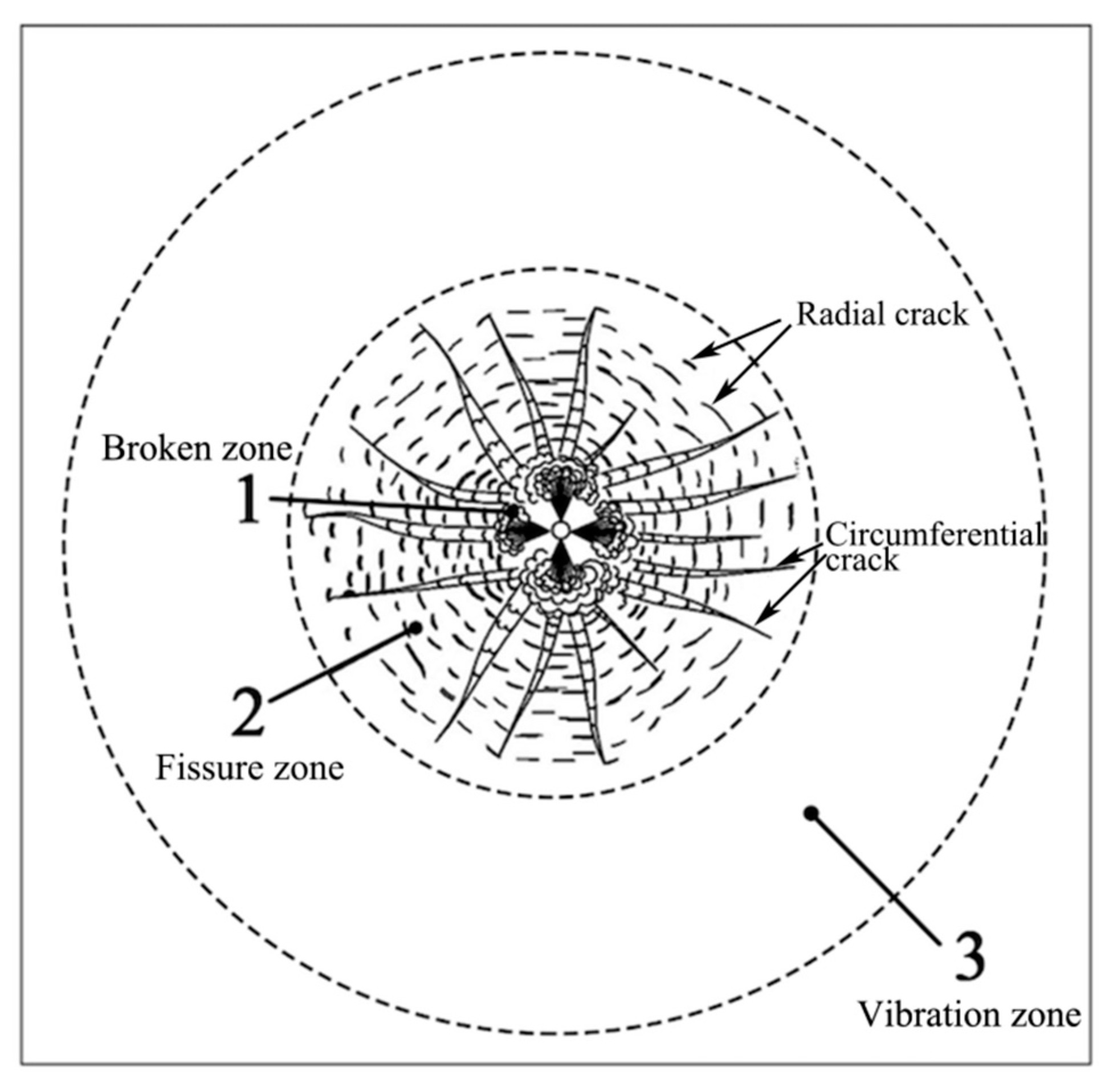
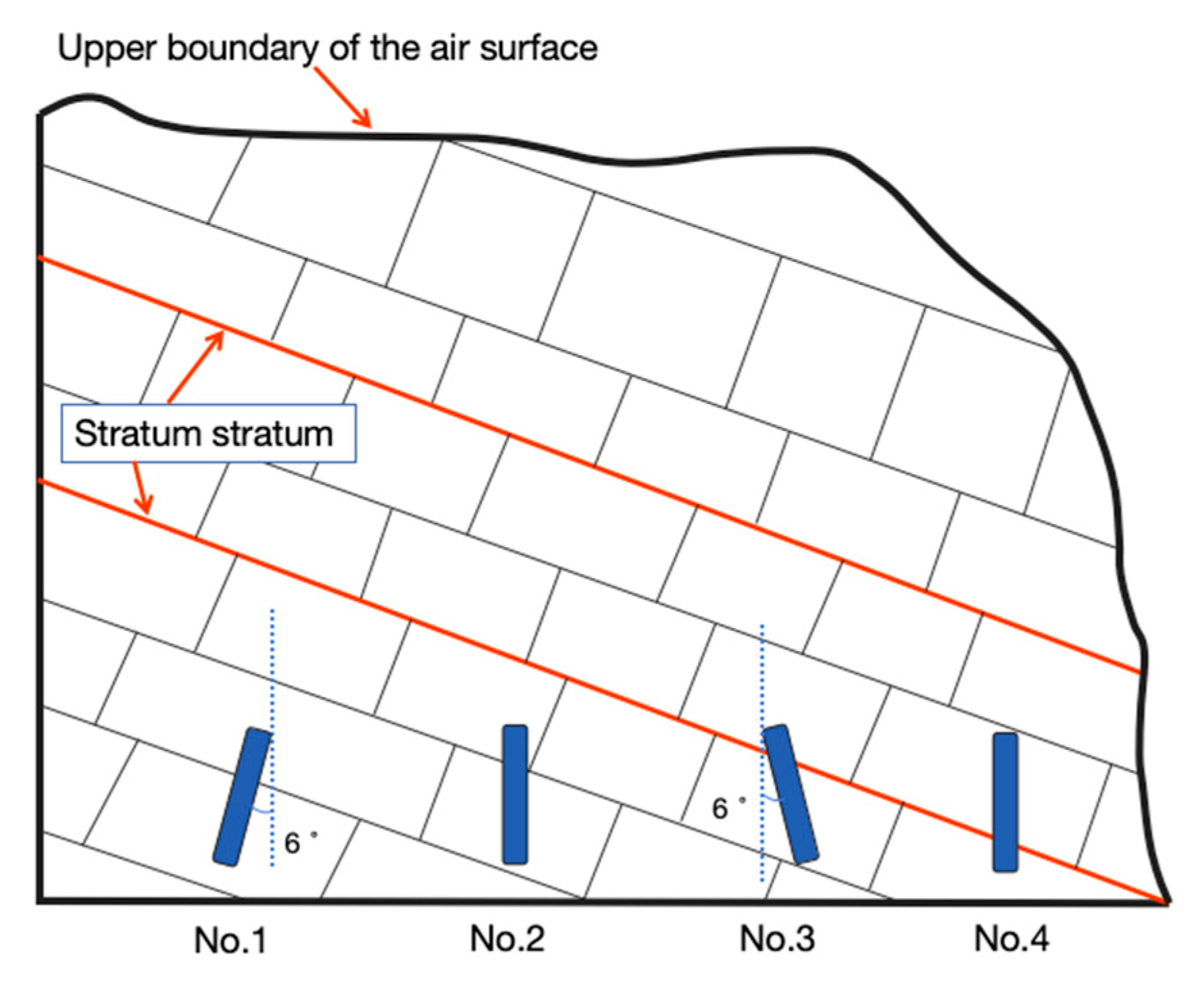

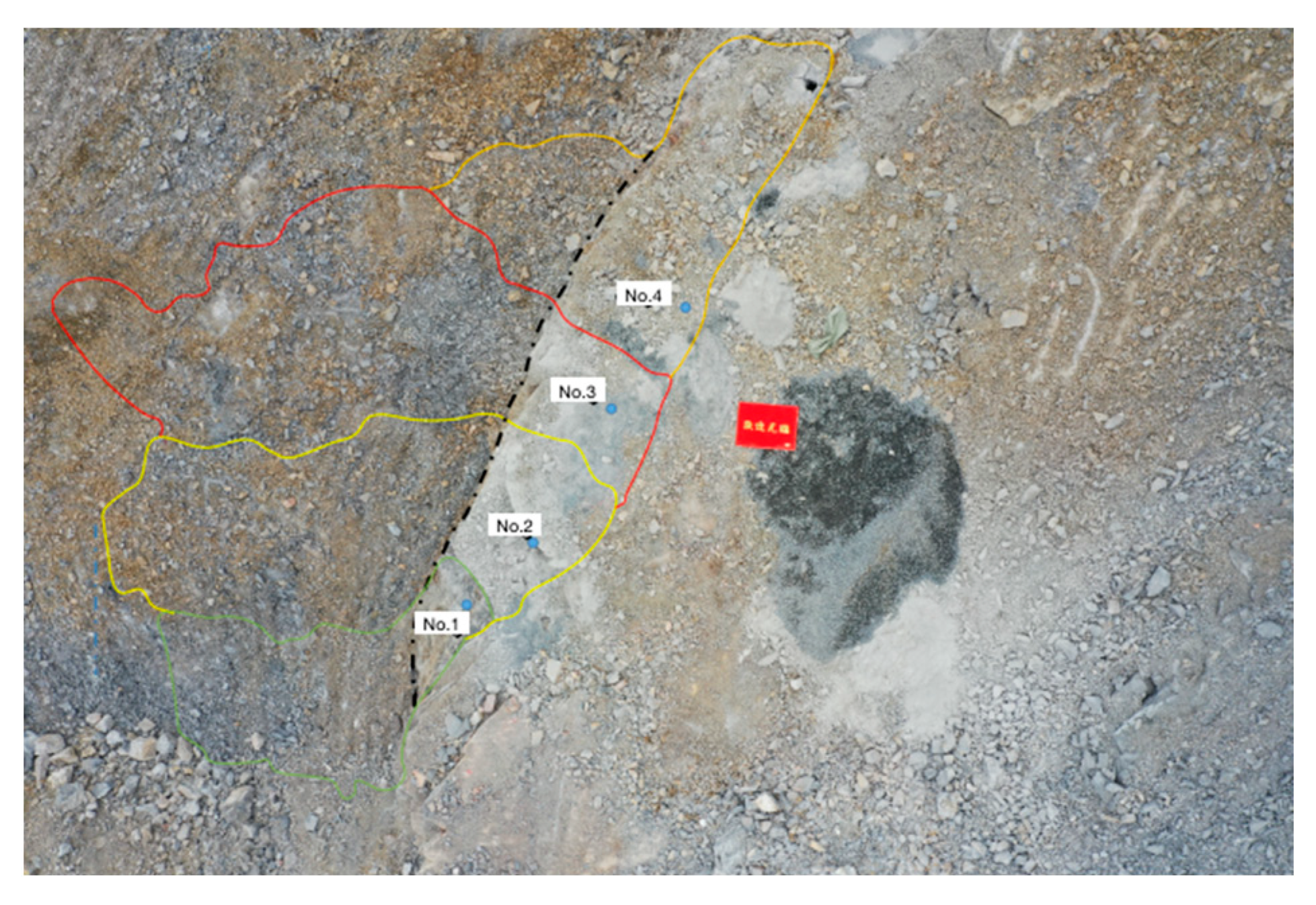
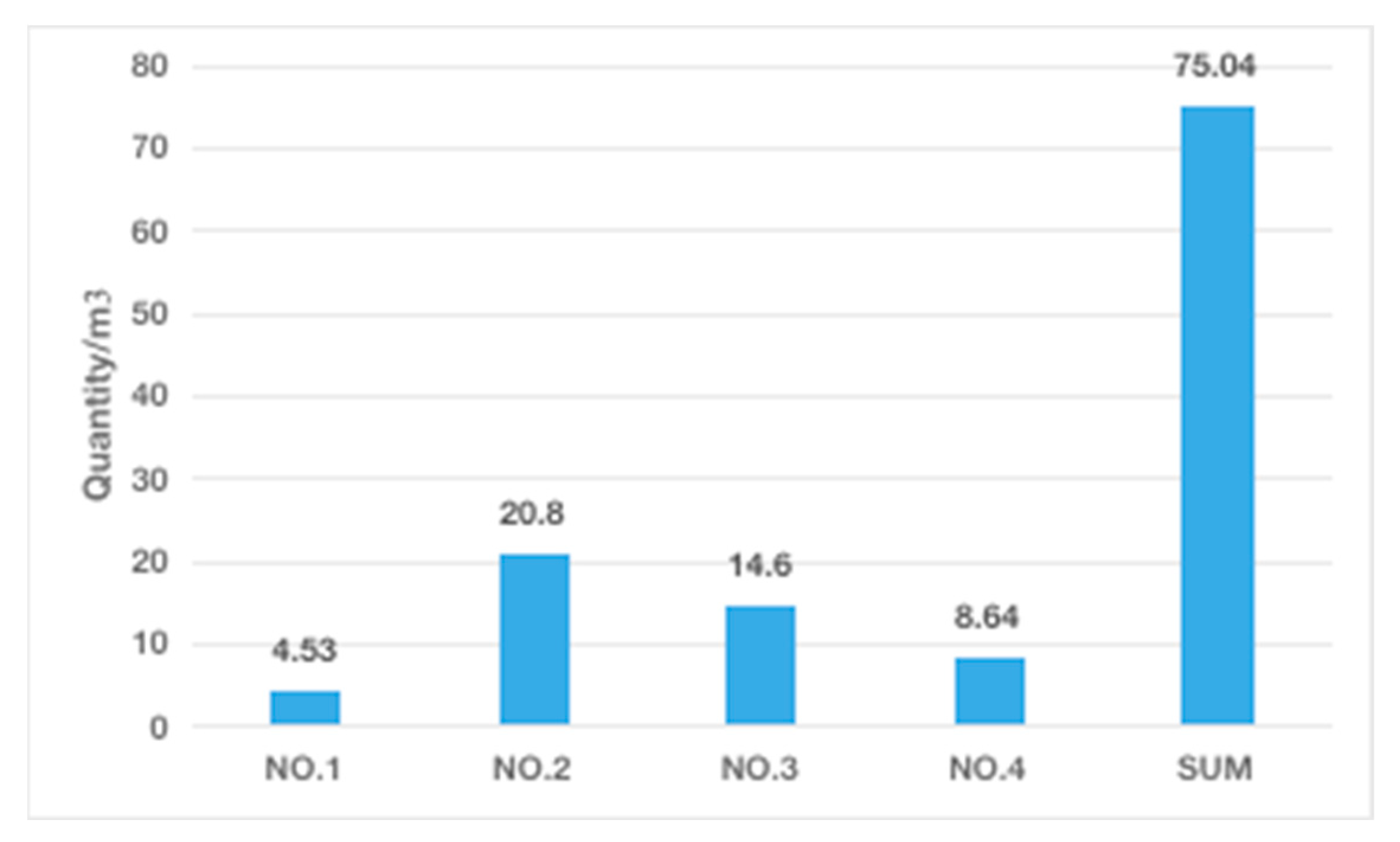
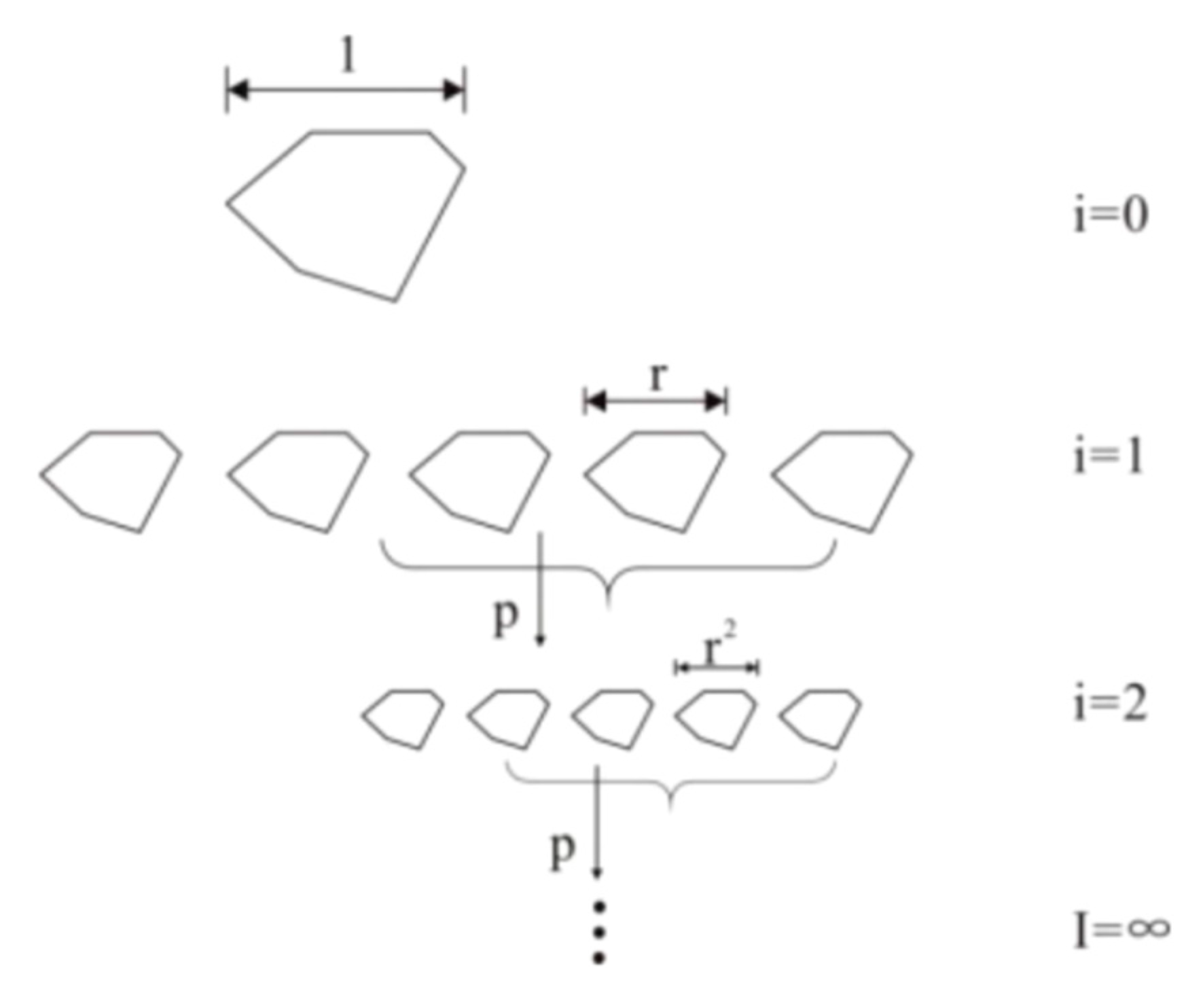




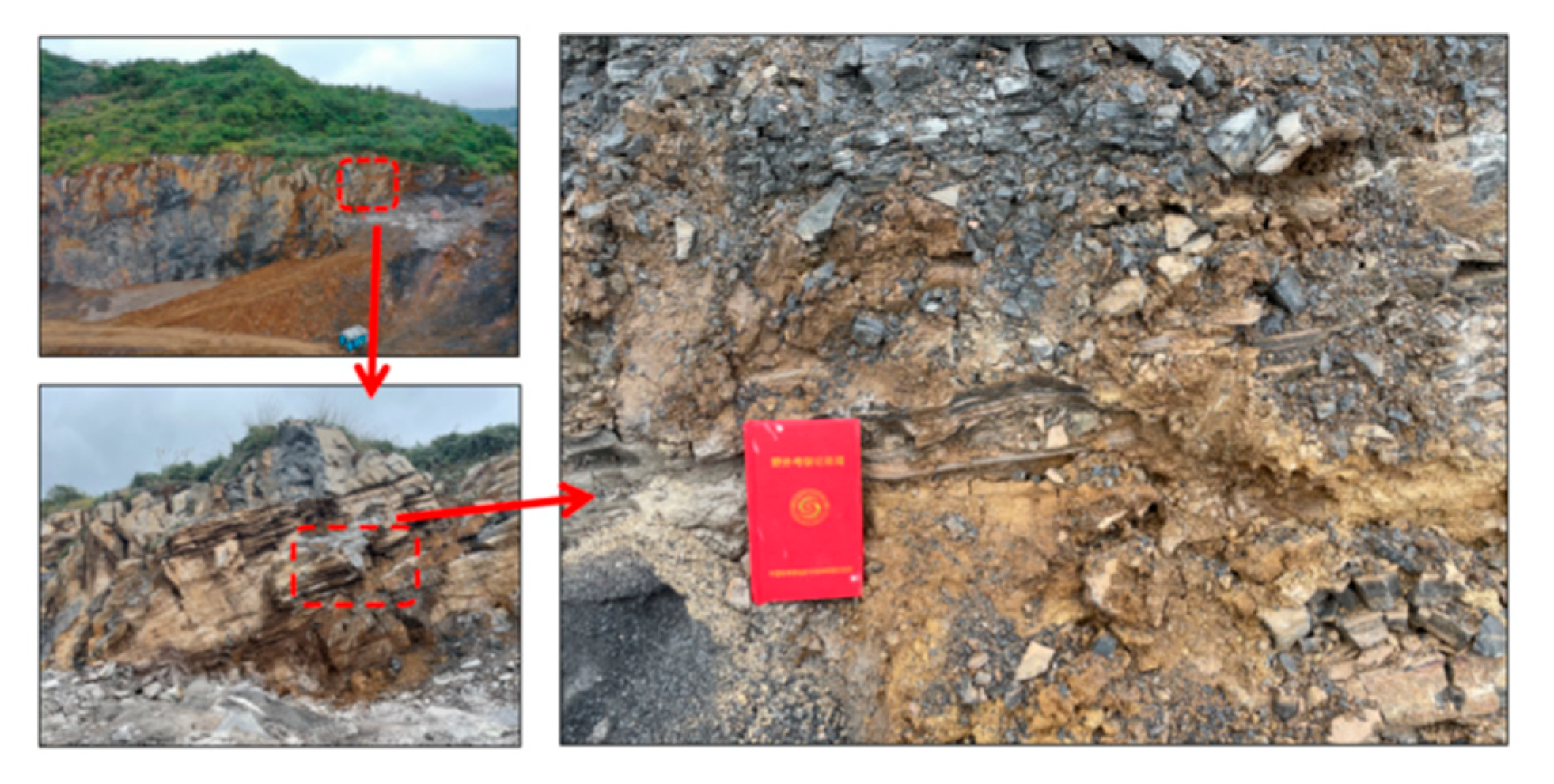
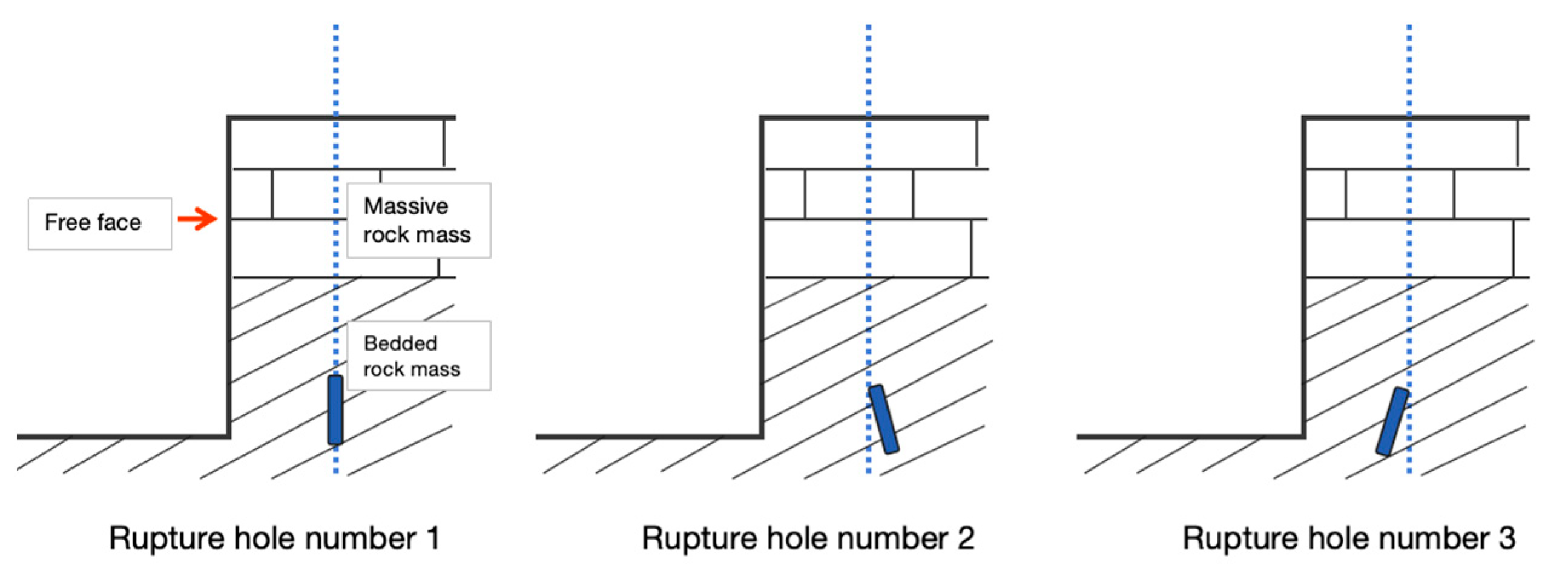

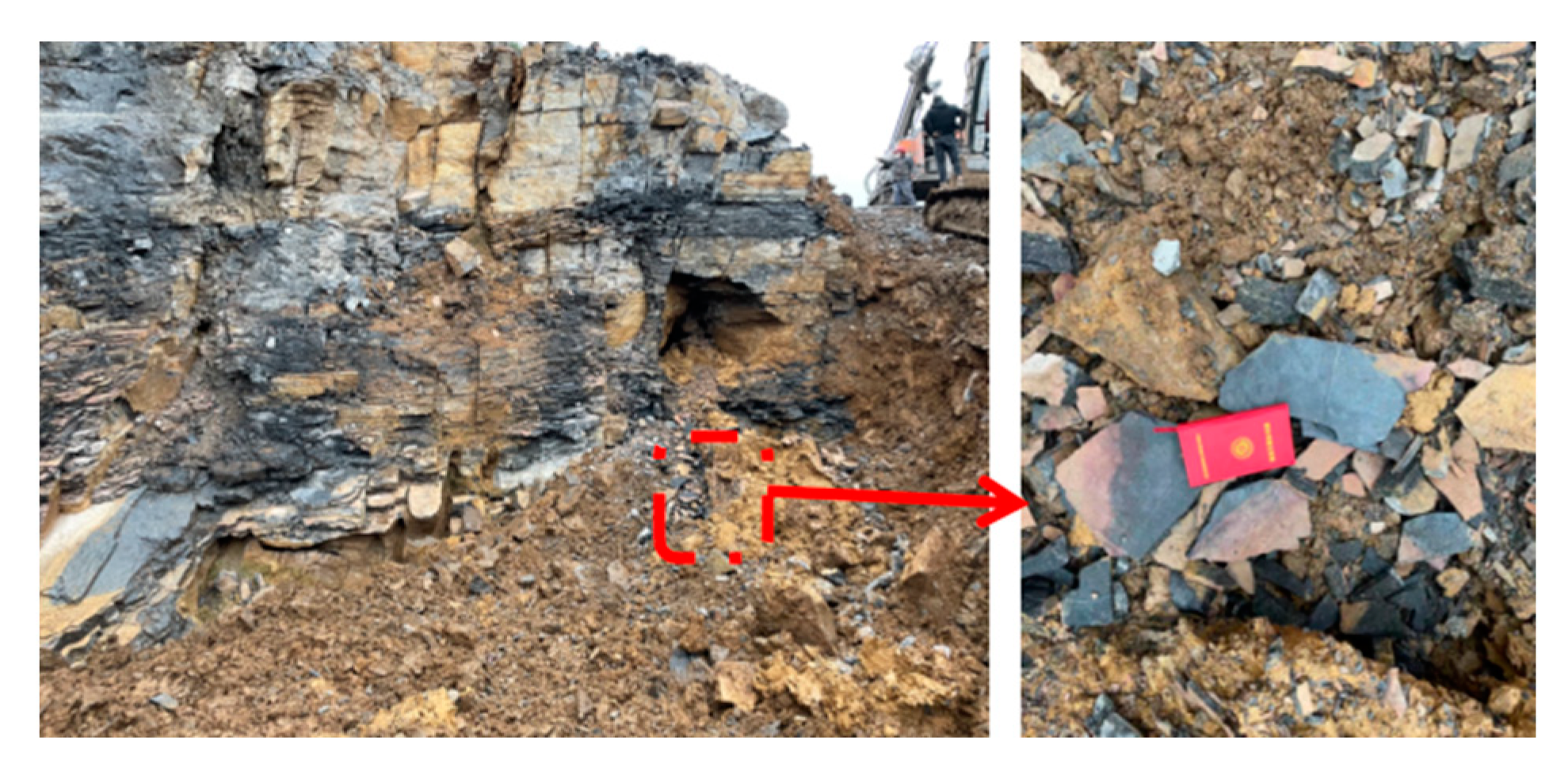

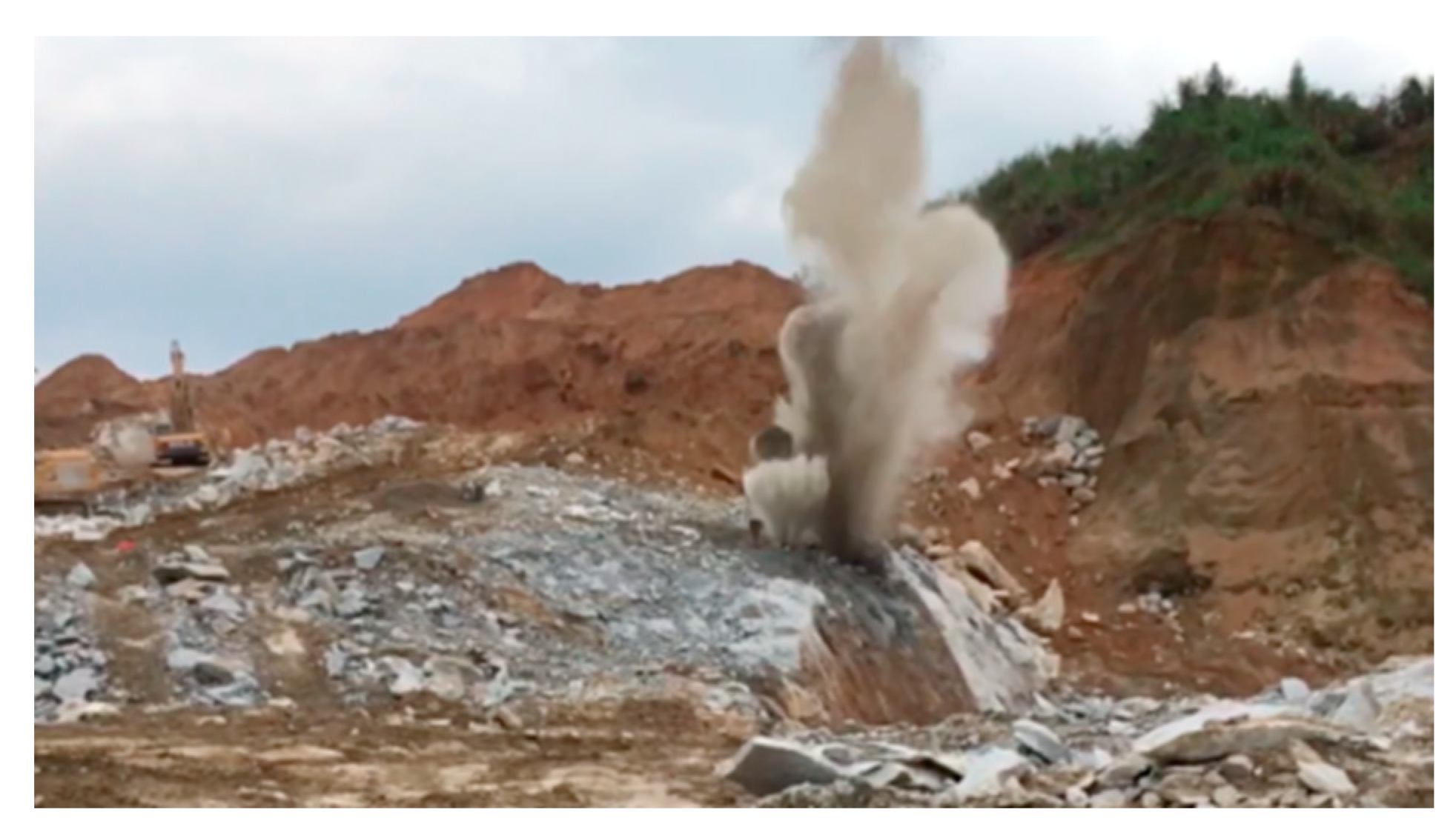
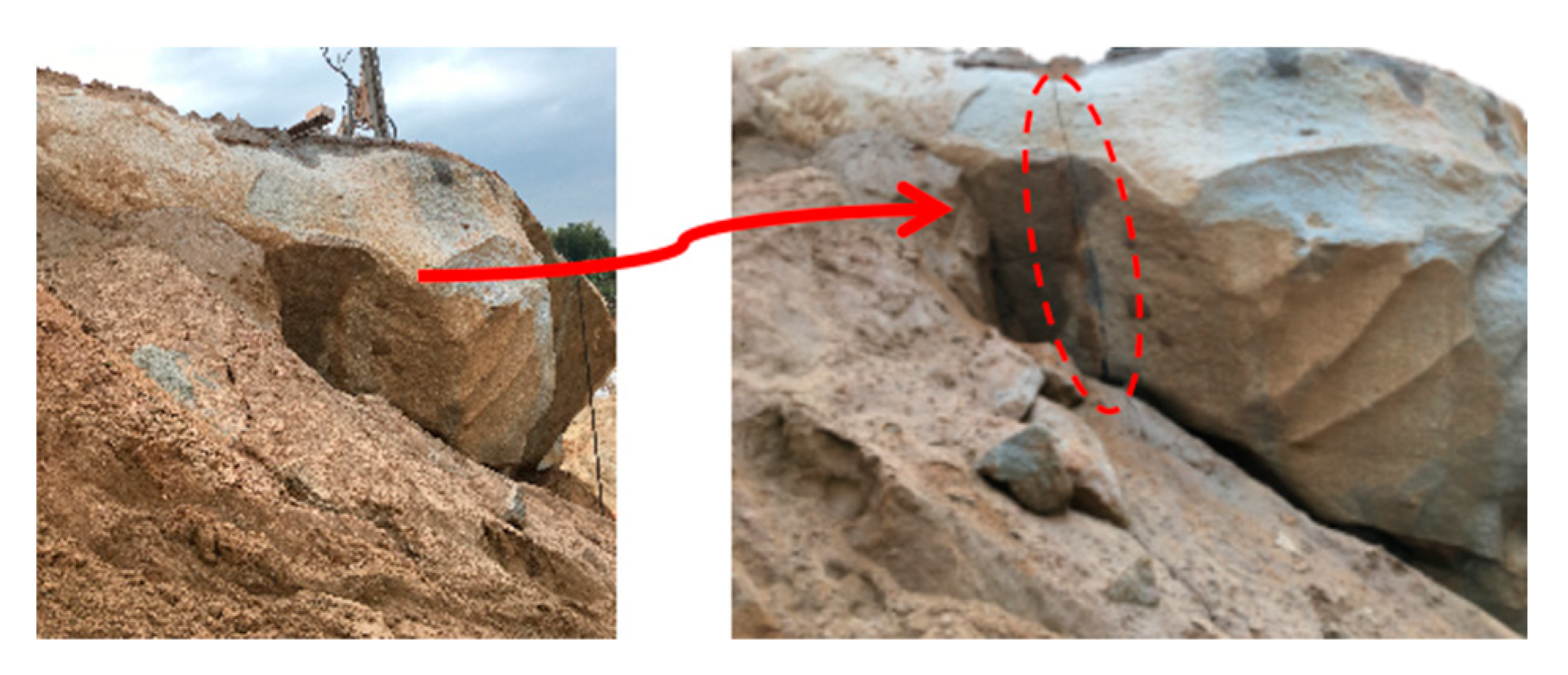
| Tube type | Tube diameter/mm | The length of the pipe/m | Fill with CO2 mass/kg | Filling pressure/Mpa |
| 90 | 90 | 1.50 | 5 | 9 |
| Height of the frontage/m | Drill hole depth/m | Hole spacing/m | Distance of resistance line/m | Drone shooting height/m |
| 4 | 4 | 1.5 | 1 | 20 |
| The Number of the Hole | 0.5 m Block Proportion | Maximum Rock Size after Fracturing/m | Fractal Dimension D |
|---|---|---|---|
| NO.1 | 18.22% | 2.11 | 1.82 |
| NO.2 | 16.01% | 2.48 | 1.86 |
| NO.3 | 13.20% | 1.76 | 1.37 |
| NO.4 | 12.68% | 2.11 | 1.57 |
| The Number of the Hole | Number of Blocks | The Average Volume of the Bulk/m3 | The Square Amount of Cleavage/m3 | Large Rate |
|---|---|---|---|---|
| NO.1 | 6 | 0.22 | 4.53 | 0.29 |
| NO.2 | 14 | 0.46 | 20.8 | 0.31 |
| NO.3 | 10 | 0.33 | 14.6 | 0.23 |
| NO.4 | 5 | 0.24 | 8.64 | 0.14 |
| The Number of the Hole | The Loose Coefficient |
|---|---|
| NO.1 | 1.62 |
| NO.2 | 1.24 |
| NO.3 | 1.40 |
| NO.4 | 1.58 |
| Tube type | Tube diameter/mm | The length of the pipe/m | Fill with CO2 mass/Kg | Filling pressure/Mpa |
| 90 | 90 | 1.50 | 5 | 9 |
| Height of the frontage/m | Drill hole depth/m | Hole spacing/m | Distance of resistance line/m | Drone shooting height/m |
| 8 | 6 | 2 | 2.0 | 40 |
| Test 3 | Test 4 | |
|---|---|---|
| Tube type | 90 | 90 |
| Tube diameter/mm | 90 | 90 |
| The length of the pipe/m | 1.50 | 1.50 |
| Fill with CO2 mass/kg | 5 | 5 |
| Filling pressure/Mpa | 9 | 9 |
| Height of the frontage/m | 4.5 | 5 |
| Drill hole depth/m | 4 | 4 |
| Hole spacing/m | 1.5 | 1.5 |
| Distance of resistance line/m | 1.5 | 1.4 |
| Drone shooting height/m | 8 | 2 |
Disclaimer/Publisher’s Note: The statements, opinions and data contained in all publications are solely those of the individual author(s) and contributor(s) and not of MDPI and/or the editor(s). MDPI and/or the editor(s) disclaim responsibility for any injury to people or property resulting from any ideas, methods, instructions or products referred to in the content. |
© 2023 by the authors. Licensee MDPI, Basel, Switzerland. This article is an open access article distributed under the terms and conditions of the Creative Commons Attribution (CC BY) license (https://creativecommons.org/licenses/by/4.0/).
Share and Cite
Li, Y.; Sui, H.; Hu, R.; Cui, F.; Qiu, Y.; Gao, W. Study on the Effect of Rock Mass Structure on CO2 Transient Fissure Excavation. Appl. Sci. 2023, 13, 12666. https://doi.org/10.3390/app132312666
Li Y, Sui H, Hu R, Cui F, Qiu Y, Gao W. Study on the Effect of Rock Mass Structure on CO2 Transient Fissure Excavation. Applied Sciences. 2023; 13(23):12666. https://doi.org/10.3390/app132312666
Chicago/Turabian StyleLi, Yong, Haoyue Sui, Ruilin Hu, Fangpeng Cui, Yidi Qiu, and Wei Gao. 2023. "Study on the Effect of Rock Mass Structure on CO2 Transient Fissure Excavation" Applied Sciences 13, no. 23: 12666. https://doi.org/10.3390/app132312666
APA StyleLi, Y., Sui, H., Hu, R., Cui, F., Qiu, Y., & Gao, W. (2023). Study on the Effect of Rock Mass Structure on CO2 Transient Fissure Excavation. Applied Sciences, 13(23), 12666. https://doi.org/10.3390/app132312666







